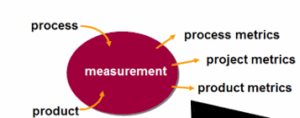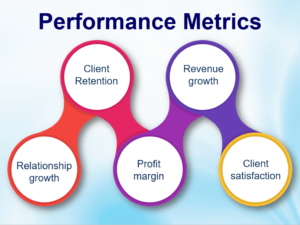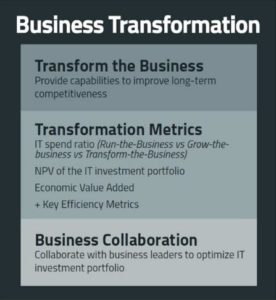
November 17, 2021
In the digital world,
success is defined by a new set of metrics

Most organizations who follow an annual planning calendar are now well into the final throws of their 2022 plans and budgets. Following their earlier strategic planning offsite, there have been multiple business unit and functional team meetings to develop specific plans and budgets to meet next year’s goals and desired outcomes.
For many companies, the focus of their planning is on where they need to adapt or transform their operating or business model in order to effectively compete as a digital enterprise. In the spirit of, “some things need repeating”, below is the blog I originally wrote on April 24, 2019 which I think still addresses critical success factors that many companies don’t do well.
What gets measured gets done

As the old adage says, what gets measured gets done. So, if you are measuring the wrong things then the wrong things are getting done. Less than 30% of companies have a process in place to measure the return on investment of their digital technology projects. As such, this lack of new measurement tools puts them at a significant competitive disadvantage as they try to pivot to being a digital enterprise.
KPI’s, OKR’s, ROI’s, NPS’s are just a few of the traditional acronyms for measuring different performance goals a company aspires to achieve. The challenge, however, is to be able to segment performance metrics based on the different ways a company creates value for its customers, employees, supply chain partners and other key stakeholders. With that thought in mind, we have developed a 4 Zone metrics framework that calls out specific measurement tools for each zone as shown on the chart below:

New performance metrics that measure the different ways your company creates value

The starting point for creating the new metrics that matter for your company is to ask some core questions:
- What performance metrics are most critical to how our company creates value?
- Do our existing metrics capture this value creation?
- What new metrics would better incent the behaviors and actions needed to create value as a digital enterprise?
- How can we leverage AI and Machine Learning to tell us what are the key performance drivers that enable our value creation process?
- What metrics are our key competitors using to measure their performance?
Measure outcomes not activities

One of the biggest mistakes that companies make is to measure activities not outcomes. For example, call centers should measure the percentage of customer problems solved not how quickly they ended the call. IT teams, instead of measuring systems uptime should measure the amount of trapped value (resources and budget) recovered and redeployed to higher value creation initiatives.
As I wrote about in my March blog, digital technology is the primary source of value creation for nearly every organization regardless of industry, sector, or geography. With the 4 Zones model, senior leaders can segment their value creation initiatives by zone where risk and return are spread across multiple value creation outcomes. As such, it is critical that the metrics that measure the performance of these initiatives are also segmented by zone. The single biggest source of failure is when a company uses the metrics in one zone to measure the desired outcome in another zone.
Using the 4 Zones Model to align value creation outcomes with the right metrics
Productivity Zone: Process Metrics

The primary role of the functions in the productivity zone including Finance, IT, HR, Marketing, Customer Service, Legal, Procurement, Compliance, and others is to enable the company’s operating businesses in the performance zone to meet or exceed their revenue, margin, and net profits goals. As such, they need to deploy a series of process improvement metrics that measure their ability to recover resources and budget trapped in low value creation functions and redeploy them to higher value functions.
A big mistake companies make in this zone is to equate cost reductions with value creation. The true measure of performance in this zone is how these support functions can leverage digital technology to directly impact and contribute to increasing revenues, margins, and profits. Ultimately functions like IT, Marketing, and Customer Service should be measured as profit centers not cost centers.
Performance Zone: Investor Metrics

Investors in public or private companies reward performance that drives sustainable value creation. The metrics that measure that performance are agreed upon during the annual planning process and often don’t reflect the increasing impact digital technologies will have on the performance of the company’s business units.
Much of the value creation in this zone comes from utilizing new systems of engagement and systems of intelligence to deliver exceptional customer experiences. Depending on whether you are a B2B or B2C business, you will need to adapt new metrics that measure how well you are engaging customers using these new systems and tools.
Incubation Zone: Venture Metrics

The biggest mistake most companies make is to use traditional performance zone metrics (e.g. EBITDA) to measure new innovation initiatives. Success in this zone comes from being able to efficiently identify, test, and validate multiple next generation products, services, and ideas. The key performance measures should be speed to market and time to value.
The reason many early stage, venture backed companies disrupt well established companies is because they outperform them in this zone. They are much better at failing fast and redeploying what they’ve learned to the next innovation opportunity. As such, the metrics they use incent that type of behavior.
The other big mistake in this zone is trying to scale multiple transformation zone initiatives at the same time. As I’ve said before, reallocating existing resources and budget from current businesses in the performance zone to create a net new business that can scale to 10% of the company’s current revenues is a very disruptive exercise for any organization. Trying to do more than one is a recipe for failure.
Transformation Zone: Hypergrowth Metrics

Value creation in this zone comes from adopting and deploying digital technologies to do two things:
- Launch and scale a material net new line of business
- Defend the company from an existential threat
In the first case, the key metrics to measure performance should include:
- The new business will scale to generate a 10% or greater increase in current revenues and profits for the company
- There can only be one transformation initiative done at a time
- 50% of the discretionary compensation of all critical stakeholders is solely based on the success of this effort
In the second case, the key metrics to measure performance should include:
- A commitment to invest in a J Curve to get to an S Curve knowing returns may take 24 months
- A compelling business case for investors that will support investing in the J Curve
To excel at value creation as a digital enterprise requires segmenting multiple performance metrics that are aligned with the different ways a company creates value. Using our 4 Zone metrics framework and toolset will allow senior leadership teams to maximize the full value creation potential of their organization. It will also help them avoid the common mistake of using the wrong metrics to measure the different ways the company creates and delivers value.
As always, I am interested in your comments, feedback and perspectives on the ideas put forth in this blog. Please email them with me on linkedin. And, if this content could be useful to someone you know please share it here:



